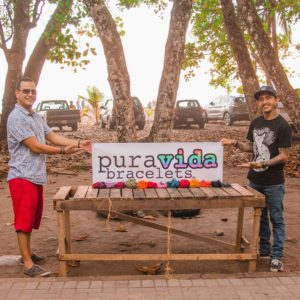We interviewed Griffin Thall, the Co-Founder and CEO of Pura Vida Bracelets, to learn how he evolved the brand from a beachside bracelet business to a multi-million dollar, globally-recognized lifestyle brand.
Founded in Costa Rica, Pura Vida Bracelets provides sustainable jobs to artisans worldwide and raises awareness for charities with products that give back. Since launching the brand in 2010, Thall has established himself as a digital pioneer in growth and content marketing, which has helped Pura Vida Bracelets scale into a multi-million dollar business.
Pura Vida Bracelets has a really interesting history and beginning. Can you explain how you started the brand?

Back in 2010, I had just graduated from San Diego State University. My business partner, Paul Goodman, and I decided to take a graduation trip to Costa Rica. We met two artisans on the beach who were making colorful string bracelets by hand. We asked them to make us 400 bracelets that we could take home with us, and we put them on display in a local boutique. They sold out within just a few days.
Fast forward to today, Jorge and Joaquin, the two artisans we met in Costa Rica, now manage the operations of over 800 artisans who hand-make all the bracelets for Pura Vida. And we’ve expanded our product line into rings, jewelry, and other accessories that we source across the world.
Giving back has always been at the core of what we do, which is why we also created the Charity Collection. Over the last few years, we’ve partnered with more than 200 charities around the world to donate over $3.3 million to causes our customers care about.
What are some of the elements that have helped Pura Vida Bracelets build a lasting lifestyle brand? How do other brands do something similar?
Our strategy has always been about creating quality products with quality storytelling—focusing on our customers, packaging, and branding.
Those are the things that, when people see Pura Vida or look at our social media, they’re like, ‘Wow this brand makes me feel something.’ Instead of just trying to sell your product, you need to create something that has much more to it. That’s what we’ve done since day one, and it’s what we’re going to continue to do.
You’ve consistently been at the forefront of new channels, like social media and paid ads. You were also an early adopter of SMS. What led you to launch the channel?
We’ve always been pretty ahead of the game with social media and email. Once SMS came out, my initial thought was if our customers would want it. Once we understood how the platform works, we realized how effective it was. If you do it the right way, it supercharges your sales. During Black Friday to Cyber Monday, we drove over $1.2 million through SMS.
Once you implement a proper strategy—such as figuring out the mix between SMS and MMS, deciding if someone in-house runs it, and what types of messages you want to send—it’s crazy to see how well it works. There are a lot of things we can still do to optimize it even further, but overall, SMS is my favorite channel.
We’ve seen a huge acceleration of e-commerce, especially on mobile. What adjustments are you making to ensure you’re creating an accessible mobile shopping experience?
We want to make sure our website mirrors where our customers are spending their time, and that’s on Instagram and TikTok. So how do we bring those content pieces—those videos and photos—to our website?
If you look at our homepage on mobile, we have these little circles below the navigation bar that closely resemble the icons you see for Instagram Stories. We know our audience spends a lot of time on Instagram, so when they jump over to our website, it feels very familiar to them.
What role has social media—paid or organic—played in Pura Vida’s growth? How are you approaching TikTok?
When we started Pura Vida back in 2010, we hopped on Facebook pretty quickly to build out a fan page. Then we joined Instagram and built out our brand presence there. Once Facebook Ad Manager launched, we were able to advertise to our audience, and that’s when we really started to see growth. But we really wanted to focus on the organic side. Back to my point earlier about being authentic—it’s about the branding and storytelling.
So once Instagram started to scale, we began working with influencers and launched brand giveaways (e.g. swipe up to follow, or follow Pura Vida to win a gift card). We were able to have a back and forth playfulness with our audience, and we saw our growth on Instagram skyrocket to two million followers.
Now that TikTok is such a prominent channel for our audience, we’re trying to figure it out. How can we “hack” TikTok in the same way we did with Instagram? I’m pretty optimistic that TikTok is going to take off much more than it has already. Once they launch an ads manager and make the channel more effective and valuable for brands, we’re going to see massive growth.
In 2019, you secured a deal with Vera Bradley, selling a majority stake in Pura Vida for $130M dollars. What led you to take this next step?
In the beginning, Paul and I were like, ‘We’re never going to sell this brand. We’ll pass it on to our kids some day.’ But once technology started developing so quickly, private equity firms and investment bankers were reaching out to us. We entertained a conversation with a company called Sage, based out of Beverly Hills, and ended up signing a deal with them to help us find the right partner.

We went on this kind of “tour” around the US, meeting with private equity firms and owners of publicly traded businesses. We had offers from seven businesses who wanted to buy Pura Vida. We chose Vera Bradley because there was so much synergy in terms of charitable components, their founders, and the loyalty we’ve both built with our customers. And we realized that they complemented our weaknesses.
They help us handle functions like accounting, payroll, HR, and accounts receivable—all the areas we would have otherwise had to hire for as we continue to scale. This allowed us to focus on what we’re really good at—e-commerce, digital marketing, and social media.
You shared that Pura Vida plans to open a physical store. What’s the driving force behind this?
I think it’s important for a brand to open up a physical store at some point, not just for the revenue but also for the branding. Give your customers a space where they can touch and feel the product; talk to employees of the brand; and live and breathe what the brand wants the customer to feel.
In June, we’re opening up a 1,000 square foot store in the UTC Mall in San Diego. Our team is super excited about it. You’re going to walk into this Pura Vida world. You’ll see photos that will make you feel like you’ve walked right into our Instagram. You’ll get this experience of beautiful natural wood flooring, different pieces of furniture, textiles, and natural rugs. You’ll really feel like you’re walking in this experience that we try to portray digitally. When our fans see it and touch it, they’re going to be blown away.
What has been the toughest part of scaling Pura Vida?
One of the most difficult things for us is inventory. We’ve always had issues with supply meeting demand—which isn’t necessarily a bad thing. Our products are hand-made in Central America, so we had to learn how to scale our operations carefully and ensure that quality control was there. It’s challenging.
We have massive purchase orders coming up this year. We have to think about whether the product will be available in time; if we’ll have enough product when Nordstrom needs a reorder, for example. It’s a good problem to have, but it’s something that’s been difficult for Pura Vida as we’ve scaled.
Explore more mobile marketing trends in Attentive Outlook 2021: The State of Text Message Marketing.
Want to meet more of Attentive’s customers? Explore our case studies.








.png)









